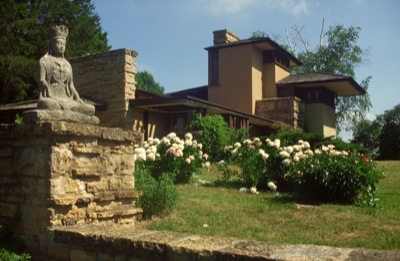
Frank Lloyd Wright designed more than 1,100 structures, including houses, office buildings, museums, churches, libraries and schools.
“His popularity stems from his desire to create architecture indigenous to America,” said Adam Ross, public relations manager for the Frank Lloyd Wright Preservation Trust. “He wanted something uniquely American. He was able to fuse so many architectural movements of the past into something uniquely American.”
One of the best ways to get to know Wright and his pioneering work is by visiting the places where he lived and worked.
“The thing I find inspiring is to think of some of the buildings that were designed in that space and what happened in that space; it was where the Prairie style was developed,” said Elizabeth Murphy, group tour manager for the trust.
Murphy was talking about tours of Wright’s home and studio in Oak Park, Ill., just outside Chicago, where he lived and worked for the first 20 years of his career. The house and adjoining studio have been restored to the way they appeared in 1909, the last year Wright lived there.
“What we focus on is the development of the Prairie style,” said Murphy.
The Prairie style incorporates Wright’s philosophy about constructing buildings in harmony with their natural settings and features low, horizontal lines and wide, overhanging eaves.
The trust also maintains the 1910 Frederick C. Robie House on the University of Chicago campus and offers tour packages that include both sites.
“What is cool is, if you go to both, you see his beginnings, where he started to play with ideas; and then at the Robie, you see where he took those ideas and fully implemented them,” said Murphy. “The Robie House is considered the most fully realized Prairie-style house.”
Tours of the Robie House, which is being renovated, include the ground floor entry, private family places such as the billiards room and the children’s room, and the main living areas on the second floor.
“We talk about what it means, why it was significant at the time, some of the structural ingenuity of the house and a little bit about the history of Wright,” said Murphy.
Groups can arrange for special twilight tours that include a reception with wine and hors d’oeuvres and tours of the third-floor family bedrooms that are not on the normal tours.
“You can experience it more like a house than a museum,” said Murphy.
www.gowright.org
312-994-4040
Taliesin
After leaving Oak Park and spending a year in Europe, Wright returned to the Wisconsin hills near Spring Green, where he was raised. There he began construction on Taliesin, which he would continue to work on and change until his death in 1959, often testing many of his ideas on the complex as it grew to 37,000 square feet.
The site, which is celebrating its centennial this year, offers a variety of tours from April 28 to Oct. 31.
“What you see [on the house tour] are primarily the living quarters,” said Becky Rex, media coordinator for Taliesin. “You see Wright’s living quarters, his personal drafting studio, his formal living room, his bedroom and Mrs. Wright’s bedroom.
“It is not a museum setting but very much a living setting. There are artifacts and reproductions of artifacts he lived with. It is not roped off. It is an intimate view of Wright’s home as he was living in it.”
The tours also delve into Wright’s often-controversial personal life. “The guides do a really good job of giving historical background about Wright the person,” said Rex.
Taliesin, which Wright twice rebuilt after tragic fires, is part of a 600-acre estate that contains several other buildings, including Hillside Home School, which Wright originally designed as an innovative school for his aunts and later converted to a studio to serve a community of architects, who still work there.
www.taliesinpreservation.org
877-588-7900










